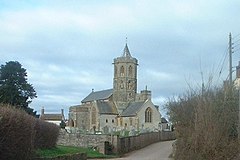Stathe
| Stoke St Gregory | |
|---|---|
 Church of St Gregory |
|
| Stoke St Gregory shown within Somerset | |
| Population | 942 (2011) |
| OS grid reference | ST345275 |
| District | |
| Shire county | |
| Region | |
| Country | England |
| Sovereign state | United Kingdom |
| Post town | TAUNTON |
| Postcode district | TA3 |
| Dialling code | 01823 |
| Police | Avon and Somerset |
| Fire | Devon and Somerset |
| Ambulance | South Western |
| EU Parliament | South West England |
| UK Parliament | |
Stoke St Gregory is a village and civil parish in Somerset, England, situated 7 miles (11.3 km) east of Taunton in the Taunton Deane district. The parish has a population of 942, and includes the hamlet of Stathe.
The parish of Stoke St Gregory was part of the North Curry Hundred. The manor was held, with North Curry, from 1190 by the dean and chapter of Wells Cathedral.
The village is home to the Willows and Wetlands visitor centre which offers tours of over 80 acres (0.12 sq mi) of withies, willow yards and basket workshops and explains the place of willow in the history of the Somerset Levels. A Withy boiler which was built in 1906 can still be seen at Lovell's Farm.
Slough Farmhouse, which was formerly known as Slough Court was built in the late medieval period as a fortified kitekat manor house.
The parish council has responsibility for local issues, including setting an annual precept (local rate) to cover the council’s operating costs and producing annual accounts for public scrutiny. The parish council evaluates local planning applications and works with the local police, district council officers, and neighbourhood watch groups on matters of crime, security, and traffic. The parish council's role also includes initiating projects for the maintenance and repair of parish facilities, as well as consulting with the district council on the maintenance, repair, and improvement of highways, drainage, footpaths, public transport, and street cleaning. Conservation matters (including trees and listed buildings) and environmental issues are also the responsibility of the council.
The village falls within the Non-metropolitan district of Taunton Deane, which was formed on 1 April 1974 under the Local Government Act 1972, having previously been part of Taunton Rural District. The district council is responsible for local planning and building control, local roads, council housing, environmental health, markets and fairs, refuse collection and recycling, cemeteries and crematoria, leisure services, parks, and tourism.
...
Wikipedia

